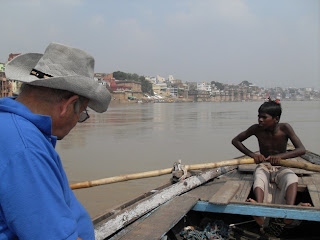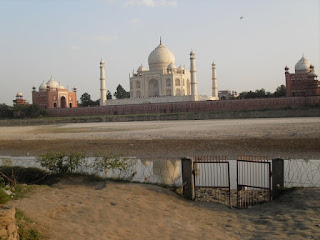Waking at dawn, and looking out from our little balcony, we could see the first bathers of the morning swimming from the steps below us.

And boatloads of tourists heading up river to see the sun rise over the Mother Ganga.
There were definitely compensations for staying right in the heart of the old Ghats.
Our "hotel" was in part of an old Maharaj's Palace and right on a main Ghat, halfway between the two cremation sites.
The evening we arrived, and found our way from the dining room where we had supper, back through the alleyway to our room, we could find the right hole in the wall to entertofind our room by the two large cows blocking the way. That was our landmark to find the room in the dark!!
Next morning they were back in the alleyway outside the way into our room !
Varanasi - alias Banares or Kashi or The Holy City is thought to be one of the most Ancient continuously inhabited Cities in the world, and certainly the oldest in India.
It is Holy to Hindu, Buddhist, Moslem and Jains.
To Hindus one must go to Varanasi at least once in your life to assist your spirit in being saved. That once can be when you are still alive - or after. In fact having Varanasi as your final resting place gives the best chance of your spirit's salvation.
So many areas of the city near the river are filled with poor old people waiting to die. They have a swim each morning in the Ganges - or Mother Ganga - and pray and wait. It is especially popular if you have no family to bury you properly - you just come here to wait for the inevitable !
We were rowed in a small boat, with a guide up the river and shown Temples, the Buddhist seminary, the Hare Krishna building and the smaller Cremation site which was busy working as usual.
Then we went down river to the larger crematorium and were shown around the site by the "Priest" who explained the rituals involved - before begging rather forcefully for donations !
Firstly the Eldest son or Husband of the deceased will shave his head and swim in the Ganges for purification.
Then the male relatives will dress up the deceased in colourful finery, and place them on a wooden stretcher affair and dunk the body in the Ganges, for the final swim.
Then the stretcher will sit on the slipway for a couple of hours to drain.
Then the top layer of finery will be unwrapped, and the body placed by relatives on a prepared wood pile. More sandalwood logs are placed on top of the deceased.
Then the special male relative will take a light from the eternal holy flame and light the fire. Several hours later when the burning is finished, any remaining large bones will be placed by the relatives in the Ganges, but the ashes will remain in the Cremation area and not be cleared away.
Small babies and certain contagious deaths will go straight into the Ganges without any burning!
The ritual, while seeming scarily hands on to us, gives the Hindu believers closure and happiness and should not be seen as a sad occasion.

And boatloads of tourists heading up river to see the sun rise over the Mother Ganga.
There were definitely compensations for staying right in the heart of the old Ghats.
Our "hotel" was in part of an old Maharaj's Palace and right on a main Ghat, halfway between the two cremation sites.
The evening we arrived, and found our way from the dining room where we had supper, back through the alleyway to our room, we could find the right hole in the wall to entertofind our room by the two large cows blocking the way. That was our landmark to find the room in the dark!!
Next morning they were back in the alleyway outside the way into our room !
Varanasi - alias Banares or Kashi or The Holy City is thought to be one of the most Ancient continuously inhabited Cities in the world, and certainly the oldest in India.
It is Holy to Hindu, Buddhist, Moslem and Jains.
To Hindus one must go to Varanasi at least once in your life to assist your spirit in being saved. That once can be when you are still alive - or after. In fact having Varanasi as your final resting place gives the best chance of your spirit's salvation.
So many areas of the city near the river are filled with poor old people waiting to die. They have a swim each morning in the Ganges - or Mother Ganga - and pray and wait. It is especially popular if you have no family to bury you properly - you just come here to wait for the inevitable !
We were rowed in a small boat, with a guide up the river and shown Temples, the Buddhist seminary, the Hare Krishna building and the smaller Cremation site which was busy working as usual.
Then we went down river to the larger crematorium and were shown around the site by the "Priest" who explained the rituals involved - before begging rather forcefully for donations !
Firstly the Eldest son or Husband of the deceased will shave his head and swim in the Ganges for purification.
Then the male relatives will dress up the deceased in colourful finery, and place them on a wooden stretcher affair and dunk the body in the Ganges, for the final swim.
Then the stretcher will sit on the slipway for a couple of hours to drain.
Then the top layer of finery will be unwrapped, and the body placed by relatives on a prepared wood pile. More sandalwood logs are placed on top of the deceased.
Then the special male relative will take a light from the eternal holy flame and light the fire. Several hours later when the burning is finished, any remaining large bones will be placed by the relatives in the Ganges, but the ashes will remain in the Cremation area and not be cleared away.
Small babies and certain contagious deaths will go straight into the Ganges without any burning!
The ritual, while seeming scarily hands on to us, gives the Hindu believers closure and happiness and should not be seen as a sad occasion.




















